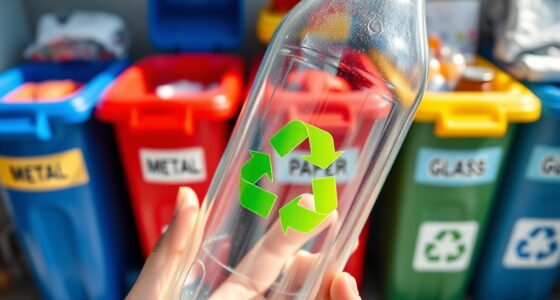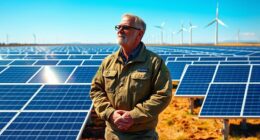You can save money and make your home more eco-friendly with low-cost upgrades like switching to LED lighting, installing programmable thermostats, sealing drafts, and adding better insulation. Using sustainable materials such as bamboo or reclaimed wood enhances style while supporting the environment. Incorporating rainwater harvesting and native plants reduces outdoor water use. Exploring energy-efficient HVAC and solar options can lead to significant long-term savings. Keep exploring to discover more simple ways to transform your home sustainably.
Key Takeaways
- Upgrade to ENERGY STAR appliances and programmable thermostats to cut energy costs significantly.
- Install low-cost water-saving fixtures and incorporate native plants to reduce water bills.
- Use LED lighting with smart controls like motion sensors and timers to minimize electricity waste.
- Seal drafts and add insulation to improve energy efficiency without major renovations.
- Incorporate sustainable materials such as reclaimed wood and bamboo for eco-friendly, affordable home upgrades.
Upgrade to Energy-Efficient Heating and Cooling Systems

Are you looking to lower your home’s energy bills and reduce your environmental impact? Upgrading your heating and cooling systems is one of the most effective ways to do this. Replacing outdated HVAC units with ENERGY STAR certified models can cut your energy use by up to 50%, saving you hundreds annually. Installing a programmable thermostat helps optimize your temperature settings, reducing costs by about 10% each year. Consider switching to a heat pump water heater, which is two to three times more efficient than traditional models, offering significant upfront savings and tax credits. Additionally, sealing drafts and adding storm windows can reduce heat loss by up to half, leading to substantial savings on your heating and cooling bills. Incorporating sound design techniques like acoustic sealing can further enhance your home’s insulation and comfort. Implementing AI security solutions can also help identify and prevent potential cybersecurity threats targeting your smart home devices, ensuring safety alongside energy efficiency. Staying informed about AI vulnerabilities and adopting security best practices can help protect your connected systems. These upgrades make your home more comfortable and eco-friendly, and exploring energy-efficient upgrades can provide additional opportunities for savings.
Harness the Power of Solar Energy for Your Home
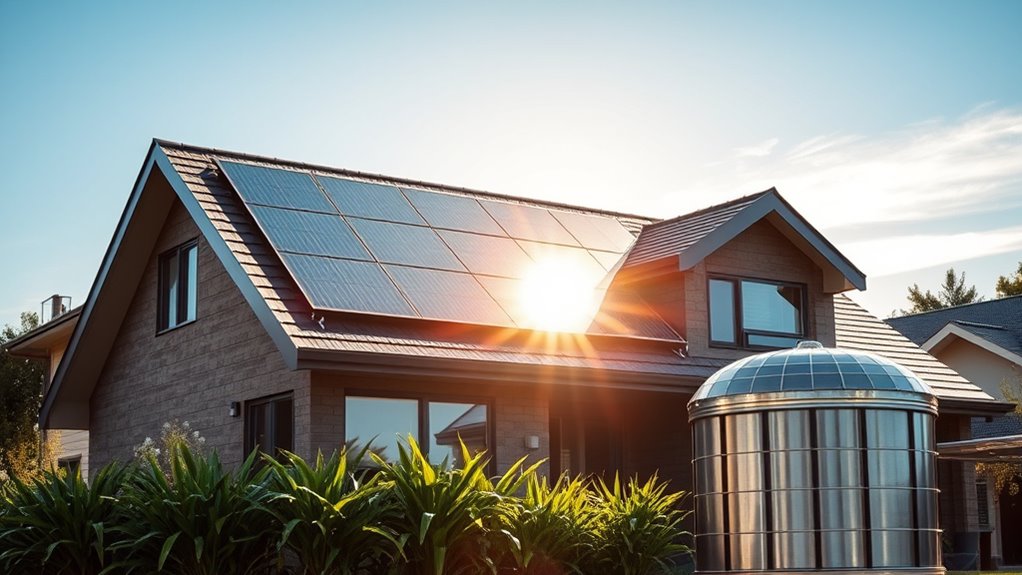
Switching to solar energy can substantially cut your long-term costs, with some systems saving you thousands over the years. Not only does it lower your utility bills, but it also reduces your home’s environmental footprint by decreasing carbon emissions. Decluttering and organizing your energy setup can optimize space and efficiency, making the most of your solar investment. Investing in solar panels boosts your property value and supports a more sustainable future. Additionally, integrating hydrogen fuel cell technology can further enhance your home’s energy efficiency and environmental benefits. Hydrogen fuel cells offer a clean energy alternative that produces only water vapor as a byproduct, making them a safe and eco-friendly option for sustainable home upgrades. Incorporating creative problem-solving into your energy planning can lead to innovative solutions tailored to your home’s unique needs. Exploring renewable energy options can also help you customize your setup for maximum efficiency and sustainability. For example, understanding energy storage solutions can ensure your home remains powered during cloudy days or at night.
Cost Savings Over Time
Over time, harnessing the power of solar energy can lead to substantial cost savings for your home. With a typical 6kW system, you could reduce your electric bill from $200 to about $15 monthly, saving roughly $2,200 annually. Although the upfront cost averages around $9,640, government incentives and rebates can cut this by nearly 30%. Solar energy adoption can also boost your home’s value; in fact, solar panels can increase property worth by up to $74,000. Over 20 years, these savings can total between $10,000 and $30,000, making solar a smart investment. Additionally, solar panels can increase your property’s value and appeal, often fetching premiums of up to $74,000. Plus, you’ll enjoy predictable energy costs and fewer fluctuations as utility prices rise. These long-term savings make solar not just eco-friendly but also financially advantageous for your household. Incorporating solar energy also aligns with sustainable home upgrades that can qualify for government incentives, further enhancing your savings. Utilizing battery technologies can also improve your energy independence and optimize solar energy use during non-sunny periods. Implementing energy-efficient appliances can further reduce your overall energy consumption and maximize savings.
Environmental Impact Benefits
Harnessing solar energy profoundly reduces your home’s environmental footprint by cutting greenhouse gas emissions and reliance on fossil fuels. By installing solar panels, you generate clean, renewable power, which helps combat climate change and air pollution. This shift decreases your home’s carbon footprint considerably—offsetting 3 to 4 tons of carbon annually, equivalent to planting about 100 trees. Additionally, solar reduces dependence on nonrenewable energy sources, promoting a healthier planet. Over time, your investment contributes to less environmental degradation and conserves natural resources. The availability of community-based programs and incentives like tax credits and rebates makes solar a cost-effective way to support ecological sustainability. Proper solar panel maintenance, such as regular cleaning and correct orientation, maximizes energy efficiency and prolongs system lifespan. By choosing solar, you’re not just saving money; you’re actively reducing your home’s environmental impact, fostering a greener, cleaner future for everyone. Incorporating renewable energy solutions like solar panels can also enhance your home’s value and resilience against energy price fluctuations.
Switch to LED Lighting and Smart Electrical Solutions
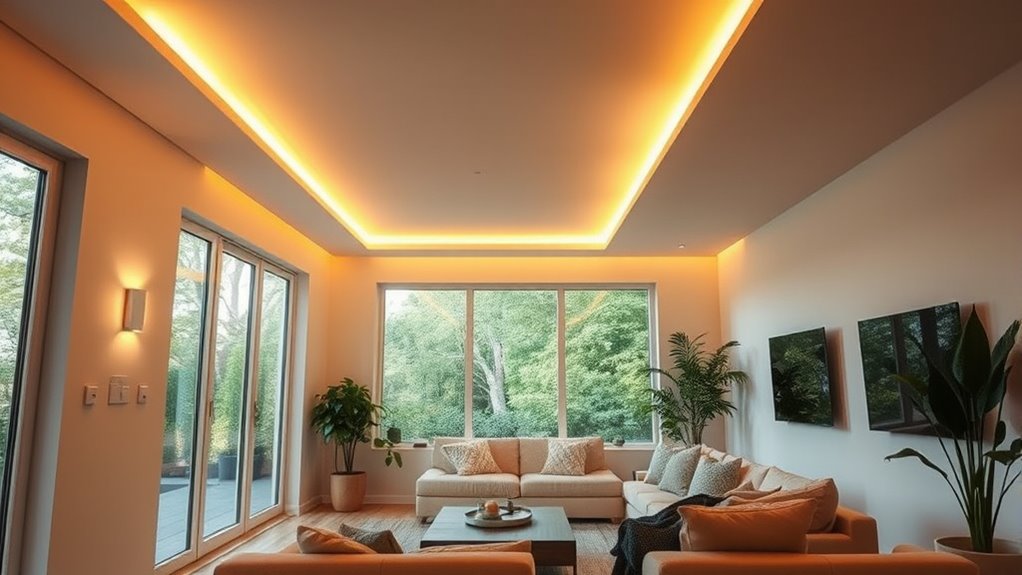
Switching to LED lighting and smart electrical solutions can considerably cut your energy bills and reduce your carbon footprint. LEDs use about 75% less energy than traditional bulbs, and smart controls help optimize usage without effort. By upgrading, you’ll enjoy immediate savings and gain better control over your home’s energy efficiency. Additionally, using wireless connectivity options like smart switches and apps can further enhance convenience and energy management.
Energy Savings With LEDS
Upgrading to LED lighting and smart electrical solutions is one of the most effective ways to reduce your home’s energy consumption. LED bulbs use about 75% less energy than traditional incandescent bulbs and last 25 times longer. Incorporating ENERGY STAR certified products boosts savings and efficiency. Smart systems like timers, motion sensors, and dimmers optimize light use, minimizing waste. These upgrades not only cut your energy bills but also lower your carbon footprint. Additionally, understanding Suction power of lighting and electrical devices can help you select the most efficient options for your home.
Smart Controls for Efficiency
Implementing smart controls alongside LED lighting and electrical solutions can substantially boost your home’s energy efficiency. Smart thermostats, timers, and occupancy sensors help you optimize energy use by adjusting lighting and climate control based on your schedule and presence. For example, programmable thermostats can lower heating or cooling when you’re away, saving around 10% annually. Smart lighting systems allow you to turn lights off remotely or set schedules, reducing unnecessary energy consumption. These solutions not only cut costs but also extend the lifespan of your appliances. Integrating smart controls with energy-efficient lighting and appliances creates a coordinated system that minimizes waste. Additionally, understanding the importance of proper installation and venting ensures your system operates safely and efficiently. Proper system maintenance also plays a critical role in sustaining optimal performance over time. Moreover, leveraging automation in business intelligence can help monitor and optimize your energy consumption patterns over time. As a result, your home becomes more sustainable and cost-effective, with lower utility bills and a smaller environmental footprint. Furthermore, adopting smart energy management systems enables real-time tracking and adjustments, making your energy savings even more effective. Incorporating personality test insights can also help tailor your energy usage habits to better fit your lifestyle and preferences, further enhancing efficiency.
Choose Sustainable Flooring Options for Eco-Friendly Style
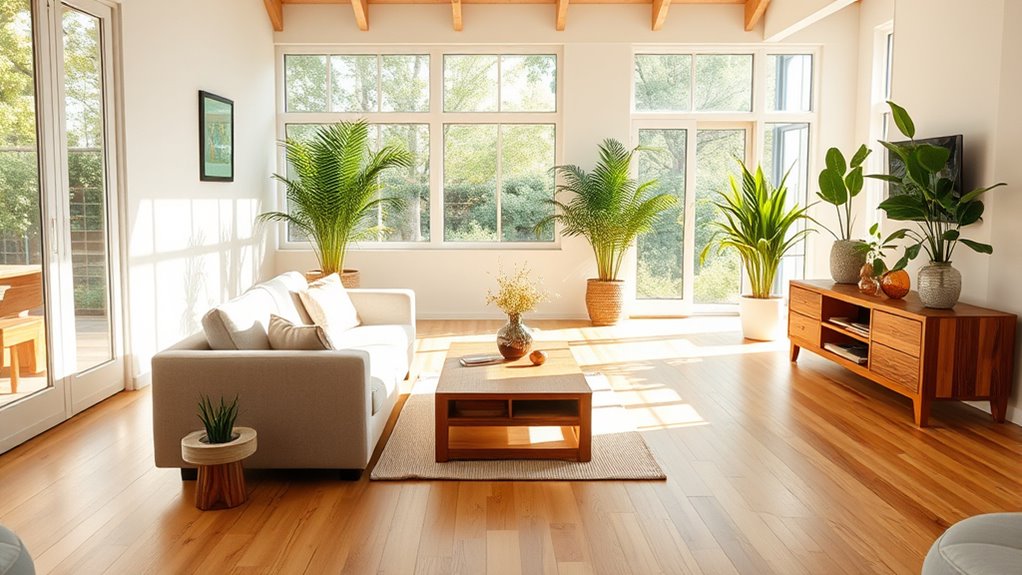
Are you looking for flooring options that combine style with sustainability? Consider bamboo, cork, or reclaimed wood—they’re eco-friendly choices that add character to your home. Bamboo grows rapidly, regenerating in just 3–5 years, making it a renewable resource, unlike traditional hardwoods that take decades to mature. Reclaimed wood uses salvaged materials, reducing waste and costs by about 30%. Cork flooring is harvested from the bark of cork oak trees, which can be stripped without harming the tree, ensuring continuous growth. Always verify certifications like FSC to guarantee responsible sourcing. These materials are durable, often requiring fewer replacements, which saves money and minimizes environmental impact over time. Choosing sustainable flooring not only enhances your home’s style but also supports eco-conscious living. Additionally, opting for flooring options like bamboo or reclaimed wood can contribute to sustainable resource utilization by reducing reliance on non-renewable resources.
Implement Water Conservation Strategies and Native Landscaping

Choosing sustainable flooring options like bamboo, cork, and reclaimed wood not only enhances your home’s aesthetic but also sets the stage for eco-friendly living. To further reduce your environmental impact, implement water conservation strategies and native landscaping. Installing WaterSense certified fixtures can cut your water and heating expenses by $70–$100 annually. Replacing traditional lawns with native plants decreases outdoor water use by up to 60%, saving around $500 yearly on irrigation. Incorporate rainwater harvesting systems and drought-tolerant landscaping to lower household water consumption even further. Native gardens support local biodiversity and require less maintenance, chemicals, and fertilizer. These practices not only save money but also promote a healthier ecosystem around your home, making your property more sustainable and resilient over time.
Improve Home Insulation and Seal Drafts for Better Efficiency

Did you know that improving your home’s insulation and sealing drafts can considerably cut your energy bills? By reducing heat loss, you’ll stay warmer in winter and cooler in summer, saving money. Proper attic, wall, and floor insulation, combined with sealing gaps around doors and windows, can cut your heating and cooling costs by 5–30%. Installing storm or double-pane windows further blocks heat transfer by 25–50%. Here’s how different upgrades compare:
| Upgrade | Estimated Savings |
|---|---|
| Seal air leaks in doors/windows | 5–15% reduction in bills |
| Add attic insulation | Up to $400/year savings |
| Install storm/double-pane windows | 25–50% heat loss reduction |
| Seal gaps around floors | 5–10% savings |
| Upgrade wall insulation | Significant long-term savings |
Maximize Savings With Programmable Thermostats and Efficient Water Heaters

Maximizing your energy savings often starts with smarter thermostat and water heater choices. Programmable thermostats allow you to set temperatures based on your schedule, reducing energy use when you’re away or asleep. Efficient water heaters, like heat pump models, use less energy to provide hot water, cutting costs over time. To optimize savings:
- Set your thermostat lower during winter nights and when you’re away.
- Use scheduling features to align temperature settings with your daily routine.
- Upgrade to a heat pump water heater for higher efficiency and tax credits.
- Maintain water heater temperature around 120°F to prevent waste.
- Insulate your water heater and pipes to minimize heat loss.
These simple upgrades can appreciably lower your utility bills while reducing your home’s environmental impact.
Incorporate Recycled and Rapidly Renewable Materials in Renovations

Incorporating recycled and rapidly renewable materials into your renovation projects can substantially boost your home’s sustainability. Using reclaimed wood, you reduce demand for new timber and keep usable materials out of landfills, often lowering costs by about 30%. Bamboo and cork are excellent choices, as they regenerate quickly—bamboo in just 3-5 years—making them more sustainable than traditional hardwoods. Recycled metal, glass, and plastic can be integrated into countertops, fixtures, and decor, minimizing environmental impact. Look for materials with FSC or other eco-certifications to guarantee responsible sourcing. These choices not only cut down on resource extraction but also add unique character to your home. By selecting recycled and rapidly renewable materials, you create a healthier, more eco-friendly space that saves money over time.
Frequently Asked Questions
How Much Can I Realistically Save With These Eco-Friendly Upgrades?
You can realistically save between 20% and 50% on your energy bills with these eco-friendly upgrades. Upgrading to energy-efficient HVAC systems, sealing drafts, and installing programmable thermostats can cut costs considerably. Solar panels and LED lighting provide long-term savings, while native landscaping and water-saving fixtures reduce ongoing expenses. Combining these improvements helps you maximize savings, lower your environmental impact, and increase your home’s value over time.
Are There Any Government Rebates or Incentives Available for These Improvements?
Think of government incentives as a green boost for your home upgrades. You can access rebates, tax credits, and grants for energy-efficient HVAC systems, solar panels, insulation, and water-saving fixtures. For example, solar projects often qualify for a 30% federal tax credit, and local rebates can cover part of your installation costs. These incentives make going green more affordable, turning your eco-friendly dreams into reality while saving you money.
How Long Does It Typically Take to See a Return on Investment?
You typically see a return on investment within 5 to 10 years, depending on the upgrade. For example, installing energy-efficient HVAC systems can pay off in 3 to 7 years through lower utility bills. Solar panels usually take about 7 to 10 years to recoup costs, thanks to savings and incentives. Insulation and sealing improvements often see returns within 3 to 5 years, providing ongoing savings and increased home value.
Will These Upgrades Increase My Home’s Resale Value?
Yes, these upgrades can boost your home’s resale value. Installing solar panels, energy-efficient HVAC systems, and eco-friendly flooring appeals to buyers seeking sustainable features. Additionally, improvements like better insulation, storm windows, and native landscaping enhance comfort and reduce utility costs, making your home more attractive. These upgrades not only increase your property’s market value but can also help you sell faster, especially as eco-consciousness grows among buyers.
What Are the Best Low-Cost Eco Upgrades for a Tight Budget?
You can start with energy-efficient LED bulbs, which cut lighting costs considerably. Installing a programmable thermostat helps optimize heating and cooling, saving around 10% annually. Seal drafts around doors and windows to reduce heat loss and lower bills. Upgrading to WaterSense fixtures cuts water use and costs. Adding native plants to your yard minimizes irrigation needs. These affordable upgrades boost efficiency and save money without breaking the bank.
Conclusion
Transforming your home into an eco-friendly haven isn’t just good for the planet—it’s like wrapping yourself in a cozy, sunlit embrace. With simple upgrades, you can slash energy bills while creating a space that breathes sustainability. Imagine your rooms glowing with soft LED light, your water-saving fixtures flowing effortlessly, and your yard bursting with native plants. Every small change weaves a greener, more comfortable home, making your sanctuary a beacon of eco-conscious living.




